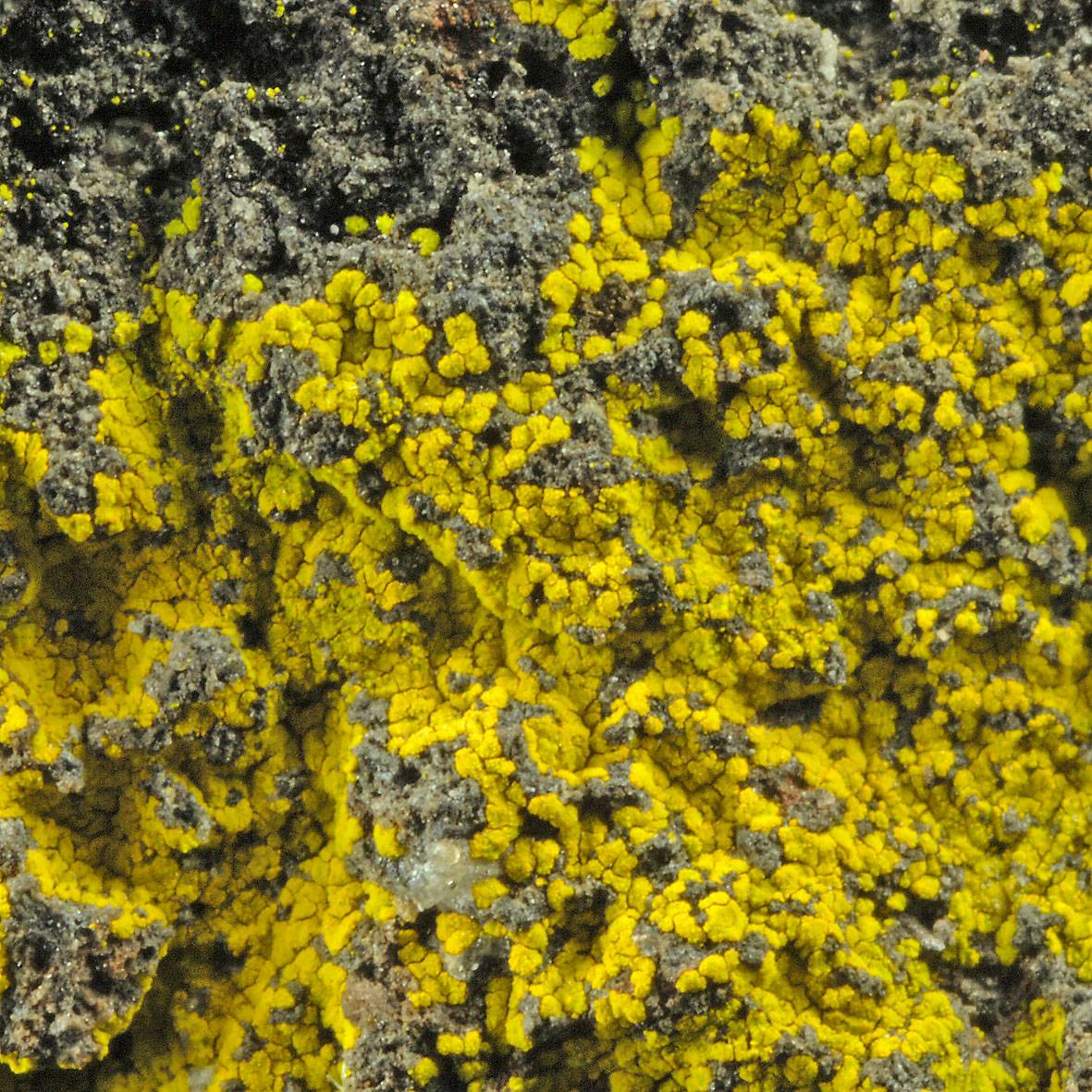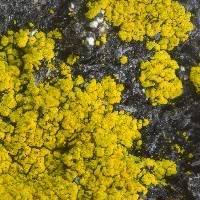
- Home
- Search
- Images
- Species Checklists
- US States: O-Z >
- US National Parks
- Central America
- South America
- US National Parks
- Southern Subpolar Region
|
|
|
|
Family: Chrysotrichaceae
|
MycoBank no. 806041 TYPE: Ecuador. Galapagos Islands: Isla Floreana: ca. 500 m S of La Lobería, ca. 200 m inland from coast, 1˚17′12.69″S, 90˚29′36″W, 20 m alt., dry zone, very open Bursera forest with Waltheria ovata, few Scalesia affinis and some grasses on lava flow, on E-exposed front of lava flow, sunny, wind- and rain-exposed, 16.i.2011, on rock, F. Bungartz 9756 (CDS 47073!, holotype; CDS!, isotype). Diagnosis. Similar to Chrysothrix placodioides, but differs in having granules generally much smaller, (150–)170–250(–290) µm in diameter, and in reproducing asexually from granules usually forming on the upper surface. Description. Prothallus of sparse thin vegetative hyphae, not apparent around mature granules, unless thallus is damaged or eroded. Hypothallus lacking. Thallus of dispersed immature granules, very compact, coarsely pseudo-corticate, (35–)42–57(–70) µm in diam. (n = 30), or of large mature granules (150–)170–250(–290) µm in diam. (n = 30), appearing pseudo-areolate, and producing immature granules on the upper surface which could be mistaken as soredia and are ultimately dispersed. Upper surface bright neon yellow, ecorticate. Photobiont green, coccoid, 7–10 μm in diam. Apothecia not observed. Pycnidia not observed. Chemistry. Calycin (major) and ±pulvinic dilactone (minor). Spot tests P−, K+ faintly reddish (10% solution), C−, KC−; UV− (dark). Distribution and ecology. The species is apparently endemic to the Galapagos Islands (Espanola, Floreana, Isabela, San Cristóbal, Santiago) where it grows on basalt boulders, rocks and cliffs in semi-shaded to sunny, exposed habitats. Most specimens were collected in the dry zone, but the species also occurs in immediate proximity to the coast or in the dry, open forests of the lower transition zone. Discussion. Chrysothrix galapagoana is most similar to C. placodioides, described from historical collections made by G.O. Malme in Brazil (Thor 1988). Like C. galapagoana, this species also has pseudo-areolate granules but they are generally much larger (often over 500 µm in diameter, n = 10). These granules have a smooth ecorticate surface and do not produce smaller immature granules on their upper surface. No apothecia have been observed on C. galapagoana. Instead of reproducing asexually, C. placodioides regularly produces apothecia. The thallus of C. placodioides looks more continuous and pseudo-areolate than that of C. galapagoana, because new granules are also formed by vegetative division. Chrysothrix candelaris as treated here contains calycin (major) and forms a distinctly leprose, unstratified, non-areolate thallus, dispersed to continuous, with mature granules 100–200 μm in diameter and immature granules from 10 μm in diameter, with a temperate distribution in Europe and not occurring in North America (Elix & Kantvilas 2007, Harris & Ladd 2008, Kalb 2001, Laundon 1981b). Chrysothrix galapagoana like C. candelaris produces calycin as a major secondary compound. It differs in having larger mature granules ((150–)170–250(–290) vs. 100–200 µm). The large granules of C. galapagoana also differ in being distinctly pseudo-areolate in appearance and in producing few to many immature granules ((35–)42–57(–70) μm) especially on the upper surface, which could be mistaken for soredia. Three sterile species of Chrysothrix also produce calycin as a major or minor substance: C. granulosa G. Thor, C. insulizans R.C. Harris & Ladd, and C. occidentalis Elix & Kantivalis. Chrysothrix granulosa differs from C. galapagoana in producing diffractaic acid (major) in addition to calycin, having a distinct hypothallus [treated as a medulla by Thor (1988)], and having smaller granules mostly 25–42 µm in diameter (Thor 1988). Chrysothrix insulizans produces calycin as a major substance and is distinguished from C. galapagoana by smaller granules (20–50 µm), a leprose thallus not becoming distinctly pseudo-areolate, and in containing an unknown secondary substance (Harris & Ladd 2008). When Harris and Ladd (2008) described this species they emphasized that the species often forms “soralium”-like patches that resemble islands (etymology of insulizans: island-forming). Harris and Ladd (2008) did not discuss, how these patches were formed and revising material of C. insulizans it is evident these patches are formed by secondary aggregation of thallus granules. The “islands” are thus typical Type-1 aggregated thalli of the common caesioalba subtype of leprose lichens (sensu Lendemer (2011)) and must not be confused with the pseudo-areolate growth of C. galapagoana, where large, mature granules themselves develop an “areolate” appearance. Recognizing that the patches or “islands” formed by some thalli of C. insulizans are only aggregations of granules these aggregations are likely not of diagnostic value and should not be stressed when identifying the species. Chrysothrix occidentalis, known from Australia and Norfork Island in the Southern Hemisphere, differs from C. galapagoana in producing leprapinic acid as the major substance with calycin only as a minor substance. Its thallus is not sub-areolate and is composed of smaller granules (mostly 20–80 µm) (Elix & Kantivalis 2007). The only other species of Chrysothrix reported from the Galapagos Islands is C. xanthina (Vain.) Kalb (Bungartz et al. 2013). It produces pinastric acid as the major substance and has a leprose thallus of smaller granules (20–40(–45) μm). This species generally grows on both bark and rock (Kalb 2001; Kukwa & Knudsen 2011) and on those substrates it is also very common in the Galapagos, whereas C. galapagoana has so far exclusively been collected on exposed rock surfaces. Chrysothrix xanthina was recently reported new for Bolivia (Flakus et al. 2006). In the CDF Checklist of Galapagos Lichenized Fungi, C. galapagoana was treated as Chrysothrix aff. occidentalis (Bungartz et al. 2013).
|



![Chrysothrix galapagoana K. Knudsen & Bungartz [Bungartz, F. 9821 (CDS 47159)] Chrysothrix galapagoana image](/imglib/lichens/CDS_Lichens/00047/CDS_47159_DX_3258_print_1556562977_tn.jpg)

![Chrysothrix galapagoana K. Knudsen & Bungartz [Bungartz, F. 5256 (CDS 29471)] Chrysothrix galapagoana image](/imglib/lichens/CDS_Lichens/00029/CDS_29471_DX_1153_print_1556561741_tn.jpg)








